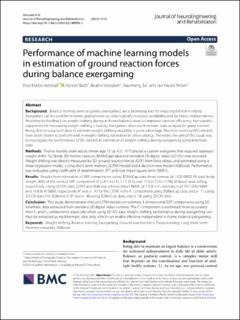| dc.description.abstract | Background
Balance training exercise games (exergames) are a promising tool for reducing fall risk in elderly. Exergames can be used for in-home guided exercise, which greatly increases availability and facilitates independence. Providing biofeedback on weight-shifting during in-home balance exercise improves exercise efficiency, but suitable equipment for measuring weight-shifting is lacking. Exergames often use kinematic data as input for game control. Being able to useg such data to estimate weight-shifting would be a great advantage. Machine learning (ML) models have been shown to perform well in weight-shifting estimation in other settings. Therefore, the aim of this study was to investigate the performance of ML models in estimation of weight-shifting during exergaming using kinematic data.
Methods
Twelve healthy older adults (mean age 72 (± 4.2), 10 F) played a custom exergame that required repeated weight-shifts. Full-body 3D motion capture (3DMoCap) data and standard 2D digital video (2D-DV) was recorded. Weight shifting was directly measured by 3D ground reaction forces (GRF) from force plates, and estimated using a linear regression model, a long-short term memory (LSTM) model and a decision tree model (XGBoost). Performance was evaluated using coefficient of determination (R2
) and root mean square error (RMSE).
Results
Results from estimation of GRF components using 3DMoCap data show a mean (± 1SD) RMSE (% total body weight, BW) of the vertical GRF component (Fz
) of 4.3 (2.5), 11.1 (4.5), and 11.0 (4.7) for LSTM, XGBoost and LinReg, respectively. Using 2D-DV data, LSTM and XGBoost achieve mean RMSE (± 1SD) in Fz estimation of 10.7 (9.0) %BW and 19.8 (6.4) %BW, respectively. R2 was >.97 for the LSTM in the Fz component using 3DMoCap data, and >.77 using 2D-DV data. For XGBoost, Fz R2 was >.86 using 3DMoCap data, and >.56
using 2D-DV data.
Conclusion
This study demonstrates that an LSTM model can estimate 3-dimensional GRF components using 2D kinematic data extracted from standard 2D digital video cameras. The Fz
component is estimated more accurately than Fy and Fx components, especially when using 2D-DV data. Weight-shifting performance during exergaming can thus be extracted using kinematic data only, which can enable effective independent in-home balance exergaming. | en_US |

